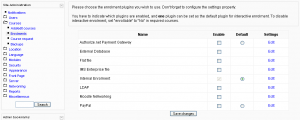Enrolment plugins: Difference between revisions
mNo edit summary |
(→Managing course enrolment: Indicate standard and contributed) |
||
| Line 5: | Line 5: | ||
Once you have set up [[Authentication|user authentication]], [[Add/edit courses|created some courses]] and assigned teachers to them, the next thing to consider is [[Enrolment|course enrolment]] i.e. assigning users the role of student in a course. | Once you have set up [[Authentication|user authentication]], [[Add/edit courses|created some courses]] and assigned teachers to them, the next thing to consider is [[Enrolment|course enrolment]] i.e. assigning users the role of student in a course. | ||
Moodle provides a number of ways of managing course enrolment, called ''enrolment plugins''. There are contributed plugins and standard Moodle plugins include: | Moodle provides a number of ways of managing course enrolment, called ''enrolment plugins''. There are [[Contributed code|contributed plugins]] and standard Moodle plugins include: | ||
*[[Authorize.net Payment Gateway]] | *[[Authorize.net Payment Gateway]] (standard) | ||
*[[External database]] | *[[External database]] (standard) | ||
*[[Flat file]] | *[[Flat file]] (standard) | ||
*[[IMS Enterprise]] (from 1.6 onwards) | *[[IMS Enterprise]] ((standard from 1.6 onwards) | ||
*[[Internal enrolment]] (default method) | *[[Internal enrolment]] (default method) | ||
*[[LDAP enrolment|LDAP]] | *[[LDAP enrolment|LDAP]] (standard) | ||
*[[Paypal]] | *[[Paypal]] (standard) | ||
*[[Moodle Network]] (from 1.8 onwards) | *[[Moodle Network]] ((standard from 1.8 onwards) | ||
*[[Enrolment/OSCommerce|OSCommerce]] ( | *[[Enrolment/OSCommerce|OSCommerce]] (contributed code) | ||
==Setting the enrolment method== | ==Setting the enrolment method== | ||
Revision as of 14:25, 20 July 2008
Location: Administration > Courses > Enrolments shows the list of enrolment plugins for your Moodle site in the site administration block.
Managing course enrolment
Once you have set up user authentication, created some courses and assigned teachers to them, the next thing to consider is course enrolment i.e. assigning users the role of student in a course.
Moodle provides a number of ways of managing course enrolment, called enrolment plugins. There are contributed plugins and standard Moodle plugins include:
- Authorize.net Payment Gateway (standard)
- External database (standard)
- Flat file (standard)
- IMS Enterprise ((standard from 1.6 onwards)
- Internal enrolment (default method)
- LDAP (standard)
- Paypal (standard)
- Moodle Network ((standard from 1.8 onwards)
- OSCommerce (contributed code)
Setting the enrolment method
To set the enrolment method:
- Click on Courses in the Site Administration block, then Enrolments.
- On the enrolments page, click the enable checkbox opposite your chosen enrolment plugin. If you wish, you may choose more than one enrolment method. For example if you have some courses which students must pay for and some free courses, you can use PayPal and internal enrolment.
- Select the default plugin for interactive enrolment (see below).
- Click the "Save changes" button.
- Click on Edit opposite the enrolment plugin(s) you have chosen.
- Configure the required settings and click the "Save changes" button.
Multi-enrolment
From Moodle 1.6 onwards, multi-enrolment is supported, with one plugin set as the default plugin for interactive enrolment.
Interactive enrolment
Interactive enrolment triggers only when a user tries to enrol on a course. The user has to do something interactively in order to be enrolled, such as clicking "Yes, I do" (Internal enrolment), or paying some money (Authorize.net Payment Gateway, Paypal).
The interactive enrolment plugin for a particular course may be selected on the Course settings page.
Login-time enrolment lookups
Login-time enrolment lookups perform a lookup against an LDAP/AD, database or SIS server. You can have several plugins set to perform login-time lookups.
See also
- Unenrolment
- Enrolment FAQ
- Using Moodle Enrolment Plugins forum
- Using Moodle Can't use External Database Enrollment Plugin forum discussion
